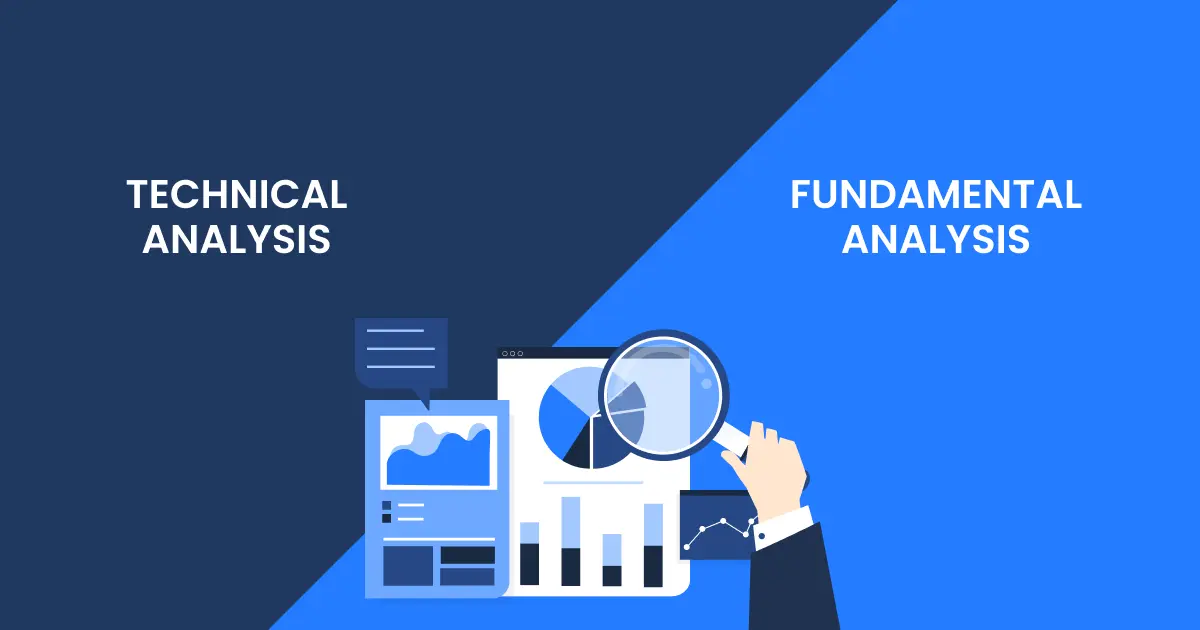Debunking The Most Common Crypto Misconceptions in 2024 Cryptocurrency and blockchain technology...

A common misconception among newcomers is that due to the high market volatility, cryptocurrencies cannot be evaluated adequately. Although an asset might be prone to the whims of international traders, one can still form a well-informed opinion about its value.
Careful investigation and analysis of all relevant measures are necessary before investing in cryptocurrencies. The majority of projects will give detailed explanations of the coin’s objective, token economy, development team, and past developments. By combining quantitative and qualitative elements, basic analysis allows you to form an opinion on cryptocurrencies.
You can learn a lot about an asset you’re interested in trading by using a variety of techniques. However, fundamental and technical analysis are two of the main methods employed by investors.
Table of contents
Anyone interested in buying cryptocurrencies must be aware of the differences between these two strategies.
Technical analysis is concerned with the past market performance of an asset. By analyzing price history and trading volume history, you can learn how the market perceives the asset. Is it going up or down? Are individuals adding money or withdrawing it? Is it exchanged broadly and in significant amounts? Technical analysis asks such questions.
In contrast, fundamental analysis focuses on the “fundamentals” of an asset. This method, which is more comprehensive than technical analysis, takes into account details such as a cryptocurrency’s financials, user base, and possible real-world uses.
Crypto fundamental analysis entails examining the elements that have an impact on the supply and demand of the digital commodity, such as the underlying technology, its adoption rate, and the mood of the market as a whole. It can be of great help for long-term traders looking to make investments in cryptocurrencies with a solid fundamental outlook.
Both methods are effective for comprehending investments. Additionally, they can help you develop a trading strategy and determine the best time to purchase or sell a specific asset.
Fundamental analysis is an essential component of decision-making processes in any investment. Therefore, understanding the technology and the issue it addresses is one of its key components in the crypto investment space.

Blockchain, the technology that underpins Bitcoin, provides a decentralized and immutable ledger system that has the potential to disrupt conventional financial organizations. Therefore, evaluating a cryptocurrency project’s propositions of success requires knowledge of both its technology and value offer.
Analyzing the project’s community and development team can also offer insightful information about the project’s viability and possibility for growth in the future. A project with a strong and committed team and a thriving community may have a long-term vision and a higher chance of long-term success.
Evaluating the project’s finances is another vital component of fundamental analysis in crypto investments. This entails evaluating the project’s funding sources, revenue streams, and general financial health. A project that has a strong financial base and a long-term business plan is more likely to withstand market volatility and turn out to be a wise long-term investment.
In addition to the cryptocurrency’s underlying technology and the team behind the project we’ve just discussed, there are a few more factors to consider when using this approach to assess a cryptocurrency investment.
Usage and adoption. The adoption and application of cryptocurrencies are essential elements to consider in crypto fundamental value analysis. Look for cryptocurrencies that are utilized in a variety of real-world settings and are broadly recognized. The value of the coin will increase over time as more people use it.
Market competition. The competitors in the market must not be ignored. Research the market share and adoption rates of competing cryptocurrencies to the one you are contemplating. It might be harder for the cryptocurrency to acquire traction if there is a lot of market competition.
Regulatory environment. When performing fundamental analysis, it’s crucial to keep in mind that the regulatory landscape for cryptocurrencies is still developing. Think about the possible effects of new regulations on the cryptocurrency you are thinking about while observing how various governments and regulatory organizations are approaching cryptocurrencies.
Investor sentiment. As you finalize your assessment of a cryptocurrency purchase, take investor sentiment into consideration. To learn how people are feeling about cryptocurrencies, look at social media and other internet forums. Positive sentiment can be a reliable predictor of potential future development, whereas negative sentiment can be a red flag for potential issues.
Understanding the underlying technology is the first step in conducting an efficient crypto fundamental analysis. Cryptocurrencies, as opposed to conventional assets, are based on decentralized blockchain networks that employ cryptography to secure transactions and confirm each transaction’s authenticity.
Therefore, in order to assess the technology’s potential and future prospects, it is crucial to comprehend it, its capabilities, and its limitations.

The total value of all coins or tokens in circulation makes up a cryptocurrency’s market capitalization. It is an important indicator for assessing the size and potential of a specific asset as a whole.
To evaluate an asset’s growth potential, investors should consider its market capitalization in relation to the total market cap of the cryptocurrency industry and its rivals.
The dynamics of supply and demand are key factors that influence the crypto market. To estimate an asset’s prospective worth, investors should assess its existing and future supply and compare it to the demand.
The distribution of coins or tokens among investors and market players can also reveal information about the mood of the market and possible price fluctuations.
The crypto market may be significantly impacted by regulatory changes. Investors should keep an eye on regulatory changes across several countries and assess the potential effects on particular assets or the market as a whole.
Investors can make better investing selections by being aware of the regulatory environment and associated hazards.
A cryptocurrency project’s team and community can offer insightful information about its potential and future prospects. Investors should assess the team members’ backgrounds, track records, and dedication to the project.
Monitoring the attitude and involvement of the community can also reveal information about prospective adoption and expansion.
There are hundreds of ventures competing for investors’ attention and money in the fiercely competitive cryptocurrency sector. When assessing an asset’s potential, investors should assess the competitive environment and take into account elements like market share, technology, and potential entry obstacles.
Both fundamental and technical analysis have their own advantages and disadvantages. Which you should employ ultimately depends on your objectives and risk tolerance.
In order to spot trends and patterns in price movements, technical analysis includes charts, graphs, and other technical indicators.
Supporters of this strategy contend that past price data may be utilized to forecast future price changes and that investors can make wise trading decisions by analyzing charts and patterns. The popularity of technical analysis is especially high among short-term traders who want to profit from swift price changes.

Fundamental analysis, on the other hand, focuses on the underlying elements that determine a cryptocurrency’s value. This strategy entails looking at a variety of economic, financial, and market elements, including adoption rates, governmental developments, and rivalry with other cryptocurrencies.
Fundamental analysis supporters believe that by comprehending a cryptocurrency’s fundamentals, investors may predict a cryptocurrency’s future value with more accuracy.
Investors can develop a more thorough grasp of a cryptocurrency’s growth potential and make better investment selections by combining fundamental and technical analysis.
For starters, it’s crucial to do extensive research on the cryptocurrency you’re thinking about investing in. This involves perusing whitepapers, researching the development team and community, and evaluating the coin’s use case and prospective market demand.
Once you have mastered the fundamentals, you can use technical analysis to find probable entry and exit points for your investment. Examining price charts, seeing trends and patterns, and using indicators like moving averages and RSI (Relative Strength Index), to determine market sentiment and momentum can all be part of technical analysis.
It’s critical to keep in mind that no investment strategy will ensure profits, and investing in cryptocurrencies is always risky. In this dynamic and quickly changing market, you can potentially boost your chances of maximizing your profits by combining fundamental and technical research to help you make more informed investing decisions.
Latest Articles
Debunking The Most Common Crypto Misconceptions in 2024 Cryptocurrency and blockchain technology...
Veli Secures Investment from DSl Angel Investor Network We are thrilled to...
How Veli Transformed Vezovišek & Partnerji Into a Digital Asset Powerhouse Cryptocurrencies,...